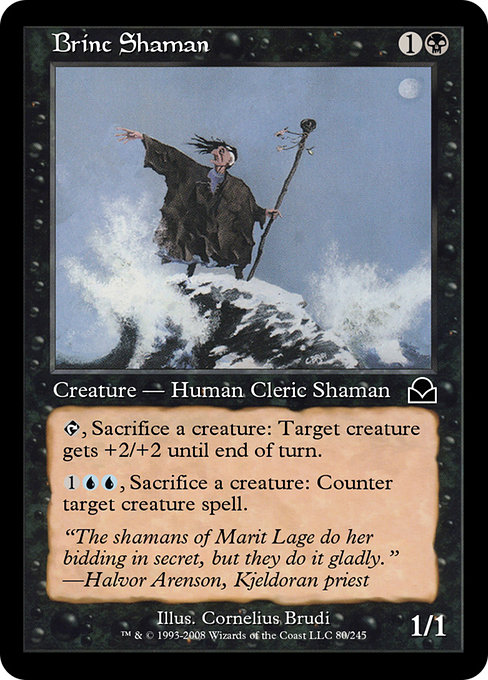
Image courtesy of Scryfall.com
Set themes shape its mechanics
Magic sets seldom drop a card into a vacuum. They ride a tide of design philosophy, lore expectations, and the broader arc of the game’s evolution. Brine Shaman, a common from Masters Edition II, exemplifies how a two-color identity can fuse thematic flavor with tangible play patterns. The black-blue combination in this card isn’t a mere color label; it’s a deliberate invitation to tempo, resource management, and the delicate dance of risk and reward 🧙🔥. In Masters Edition II—an older-meets-new reprint era—the designers leaned into nostalgia while preserving a functional, in-game conversation between mechanics. The card’s two distinct abilities echo that ethos: a black-centered sacrifice engine and a blue-centered counter option, all while existing comfortably within a Masters-era constraint on power level ⚔️.
Two colors, two strategic levers
Look closely at the card’s mana costs and effects, and you can hear the thematic drumbeat of set design:
- Black lever: Tap to sacrifice a creature and give a target creature +2/+2 until end of turn. It’s a straightforward combat trick that rewards creature-rich boards or token work, a classic black move that punishes awkward blocks or creates a surprise alpha strike. The sacrifice requirement isn’t incidental; it mirrors the long-running black motif of extracting value through exchange and sacrifice, a theme you’ll see echoed across many Masters-era reprints 🧙🔥.
- Blue lever: For {1}{U}{U}, sacrifice a creature to counter a target creature spell. This is blue’s tempo finished, a clear counter-magic push that punishes threats specifically targeting the round, creature-based boards. The fact that you must sacrifice a creature to counter a creature spell nods to set-wide themes about resource allocation and the idea that countering threats often comes at a relational cost rather than an infinite gas tank. It’s a clever pairing with Masters Edition II’s flavor of cunning, where shrewd players balance board presence with disruption.
Practical gameplay in a Masters-meets-modern frame
In practice, this card thrives when you’re leaning into "creature-based value" while keeping a lid on the opponent’s threats. The buff-yet-sacrifice dynamic lets you swing for damage and still maintain board presence—just be mindful of how many creatures you’re willing to part with in any given turn. The counter-magic option, though situational, can be a powerful tempo tool in the right matchup, especially when your opponent leans hard on creature-based engines. Together, these abilities paint a picture of a deck that doesn’t rely on one trick but rather on a layered plan: pressure, disruption, and a timely spike in power on the battlefield 🧲🎲.
Lore, flavor, and the art of restraint
The flavor text—"The shamans of Marit Lage do her bidding in secret, but they do it gladly."—pulls you into a world where hidden networks of power pull strings that players rarely see until the moment they arrive on the battlefield. Marit Lage herself is a nod to eldritch depth and underworld ambitions, a thread that designers use to justify why a single creature might be both a catalyst for aggressive play and a counter-magic engine. In this sense, the card’s dual mechanics aren’t random curiosities; they are the flavor realized in mechanical form. The art by Cornelius Brudi, with its moody black frame and the Gothic vibe that Masters Edition II sought to evoke, reinforces that sense of a living, breathing underworld where sacrifice and cunning mingle with a pinch of cosmic dread 🎨.
Design, balance, and the collector’s mind
From a design perspective, the card sits at a deliberate power level for a common slot in a Masters reprint set. It’s a two-mana creature in a color pair that can both disrupt and surprise. The me2 print carries nostalgia for players who remember the era when “two colors, two jobs” was a common blueprint for flexible, kick-out-the-clutch play. In EDH/Commander discourse, Brine Shaman earns a cameo-worthy spot thanks to its mana efficiency, versatility, and the way its effects scale with a board full of creatures—the kind of synergy a casual table loves to explore. If you’re chasing value in a two-color shell that leans into tempo and control, this card quietly earns its place on the shelf alongside other classic masters reprints 🧙🔥💎.
Where to go next: theme-driven deck building
For players chasing a theme-driven deck, Brine Shaman offers a natural blueprint: build around sacrifice outlets and creature-based disruption. Pair it with cheap creatures to feed the buff and the counter, weaving a rhythm where you threaten damage while your opponent anticipates a crisis a turn away. The set’s emphasis on nostalgia and clever sequencing rewards players who plan several turns ahead, balancing aggression with protection. And because the card lives in a color identity that enjoys both swarms and silencing, you’ll find that the best experiences come from tight, thoughtful sequencing rather than brute force.
While you’re fine-tuning your tabletop ritual, a small but handy addition can elevate your setup: a reliable, customizable mouse pad to keep track of life totals, turn order, and token counters. If you’re shopping for gear that complements long sessions of deckbuilding and playtesting, consider this option: Round Rectangular Vegan PU Leather Mouse Pad Customizable. It’s a neat, practical companion to live-play nights, helping you stay organized as you navigate the joys of niche card interactions and timeless lore 📦🎲.